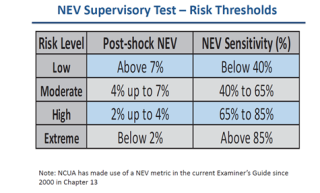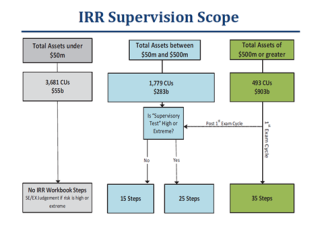A Brief Preview of NCUA’s New Interest Rate Risk Supervisory Tool
Written by Michael Emancipator, Senior Regulatory Affairs Counsel
In a webcast last Thursday, August 18, NCUA’s Office of Examination and Insurance (E&I) provided a background and overview of its upcoming interest rate risk (IRR) supervisory tool. NCUA stated that the IRR tool and guidance is expected to be published in the next few months, with official use during examinations no earlier than January 2017. While we were pleased to see that NCUA did not include an IRR component in RBC2, many experts have been paying close attention over the last several months to this issue for the impact of IRR supervisory guidance on credit unions. We will keep members posted once the agency releases the full tool and guidance, but in the meantime, we wanted to share a few high-level components from this E&I webcast to give you a better sense of what to expect.
First, the agency stated that the goals of the new tool include: improving the clarity of guidance, consolidating and unifying the guidance, reducing inconsistency of examiner interpretation, and instituting means through which NCUA can collect uniform and comparable IRR information across the industry to better identify outliers.
The agency also asserted this change will result in a number of benefits for credit unions. For example, NCUA claimed that the new tool will enable it to better focus on the risk outliers, and thereby reduce focus on lower risk institutions. Additionally, by creating a risk-based scope for IRR, NCUA hopes to gain savings in the time spent on IRR reviews and increase the agency’s ability to determine where it needs to send specialized staff.
So how will the new tool work? NCUA explained that the new IRR supervisory exam will utilize a risk-based scoping approach, the result of which will drive whether there is an increase or decrease in the number of required review steps, which also depends on the credit union’s asset size, as seen in the figure below.
The risk categories used for the scoping are tiered based on the levels of post-shock net economic value (NEV) ratios and the NEV change sensitivities. These classifications are designated as low, moderate, high, and extreme, and they serve as the primary guidepost for the overall IRR supervisory rating. The risk tolerance thresholds that NCUA will use to assign a supervisory risk rating to a credit union's IRR is found on a traditional NEV plus or minus 300 basis point shock test approach. In order to evaluate the level of market risk in a balance sheet, NCUA will first review the credit union's current base case and shock NEV levels, and then assess both the absolute level of the post-shock NEV ratio, as well as the total percentage change of NEV from the base to shock scenarios. Both thresholds apply, so either measure triggers the assigned risk level.

Finally, the webinar also briefly touched on how these IRR supervision changes relate to the CAMEL rating system. Currently, NCUA assigns a supervisory risk rating to IRR as part of the L rating of CAMEL. NCUA proposes to continue this approach for the immediate future until the Board decides it wants to move forward with an S.
Importantly, though, NCUA has determined that adding S to CAMEL will require NCUA to reprogram numerous internal systems, and that a number of existing documents in supervision programs would require revisions. This means that if the Board wanted to adopt S, any such implementation would take several years.

